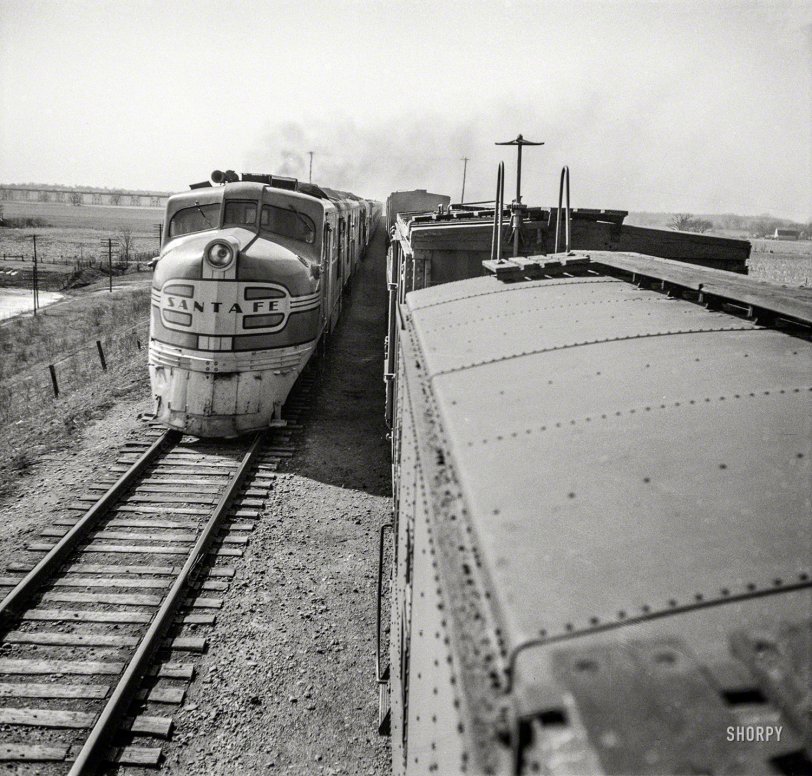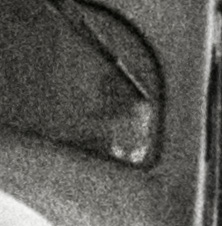


Framed or unframed, desk size to sofa size, printed by us in Arizona and Alabama since 2007. Explore now.
Shorpy is funded by you. Patreon contributors get an ad-free experience.
Learn more.

- Baldwin 62303
- Baldwin VO-1000
- Cold
- No expense spared
- Tough Guys
- Lost in Toyland
- And without gloves
- If I were a blindfolded time traveler
- Smoke Consumer Also Cooks
- Oh that stove!
- Possibly still there?
- What?!?
- $100 Reward
- Freeze Frame
- Texas Flyer wanted
- Just a Year Too Soon
- WWII -- Replacing men with women at the railroad crossing.
- Yes, Icing
- You kids drive me nuts!
- NOT An Easy Job
- I wonder
- Just add window boxes
- Icing Platform?
- Indiana Harbor Belt abides
- Freezing haze
- Corrections (for those who care)
- C&NW at Nelson
- Fallen Flags
- A dangerous job made worse
- Water Stop
Print Emporium
Electro-Motive: 1943

March 1943. "Sibley, Missouri. Passing one of the diesel passenger locomotives of the Atchison, Topeka and Santa Fe." Medium format nitrate negative by Jack Delano for the Office of War Information. View full size.
Brake wheels
Brake wheels on freight cars were for many years in the horizontal position like this one, on the car ahead of the caboose, from which Delano took this photo. For years, brakemen rode the tops of freight cars during yard switching procedures. This practice was outlawed for sound safety reasons. I seem to recall after WWII that brake wheels started to appear on the ends on cars instead. Does anyone know the date that this transition took place?
Rare Breed.
When the 50 set was delivered, the Super Chief was usually powered by an A-B set of E-units, so an A-B set of Alcos fit the operating practice. They got off to a bad start - Santa Fe Locomotive Development says the Santa Fe rep attending the roll-out at Schenectady observed the carbodies shaking vigorously to the beat of the four idling 539's and refused to accept them. The structure was stiffened to reduce the shake and Santa Fe eventually took them, but even then, the locomotives' gyrations could reportedly be felt back in the train at station stops. The account of their first westbound run on the Super in McCall's Santa Fe Early Diesel Daze suggests that they all but melted the traction motors down to the ballast going over Raton Pass. After returning east, their career on extra-fare long distance trains was over, and naturally no repeat orders were forthcoming. Santa Fe wouldn't look to Alco for passenger power again until the PA's and PB's were introduced after the war. Santa Fe generally found uses for the 50L&A on lower grade assignments east of the Rockies like the Chicagoan or the Tulsan. Unlike the PA's, 50L&A could and did MU with EMD power, and several photos exist of them in mixed consists with E-units, turret cab 1L, or booster 1A.
East Sibley
I'd say the photo was taken about right here.
In the distance, to the left of the passenger train, you can see the trestles on the approach to the bridge over the Missouri River, where the track curves south. The pond and road on the south side of the tracks are still there.
Today (and probably back then too), the line is double-track on either side of the bridge, but single-track on the bridge. The freight that Jack is on probably had to wait for the passenger train to come across the bridge. Even today, I sometimes hear the BNSF Marceline Subdivision dispatcher (on the scanner) asking a train to wait at "East Sibley" for another train.
Currently, the only passenger train on this route is Amtrak's Southwest Chief - its next stop west is Kansas City, MO and its next stop east is La Plata, MO.
Also, the guy on the near side of the passenger locomotive seems to be really well dressed - hat, shirt, tie, jacket. Would the conductor normally ride up there, or is something else going on?
Missouri River
Bottom land required the elevated tracks seen in the background.
Bad day coming to Black Rock
I see a hat, a coat, and a tie - is that Spencer Tracy sitting in the cab?

























On Shorpy:
Today’s Top 5